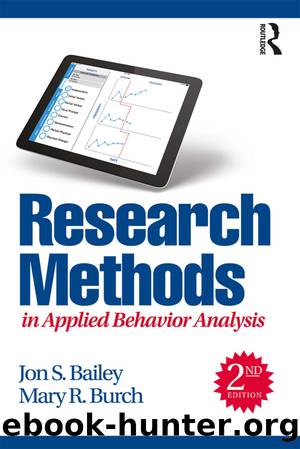Research Methods in Applied Behavior Analysis by Jon S. Bailey & Mary R. Burch

Author:Jon S. Bailey & Mary R. Burch
Language: eng
Format: epub
Publisher: Routledge
Published: 2017-03-22T00:00:00+00:00
Recommended IOA Procedures
There are several standard procedures for carrying out observer agreement checks. First, these second observers should have the same vantage point for their observations as the primary observer. They should be roughly the same distance away and have approximately the same angle of vision of the target participant as the primary observer. The two observers must not be able to respond visually or audibly to one another’s scoring. This involves several correction factors. If observers are seated side by side, one may be able to tell when the other is making a mark. Thus, the observation code should require a mark in every interval, not just when a target behavior occurs. Some convention such as a plus (+) sign if the behavior occurs and a zero (0) if it does not occur is standard. Some experimenters will use an observation sheet with preprinted symbols in the boxes; the observer then simply checks or circles the appropriate symbol in each box. If the observers are using counters instead of data sheets, steps must be taken to ensure that one observer cannot hear the other’s clicks.
To ensure that both observers are using the exact same interval for scoring, special procedures are often instituted. To ensure the observers remain in synchrony, some signal at the beginning of each minute period may be used; the second observer may quietly whisper “two” to designate the beginning of second minute of observation, for example. If the second observer finds herself out of synchrony, she is instructed to mark the spot and go immediately to the correct interval.
Another method to improve observer agreement is to have observers responding to the same cue. Thus, a large electric sweep-second or digital clock may be mounted on a wall in line of sight of both observers. Another system is more elaborate and involves the observers’ getting their cues for observation from an audible signal. This may be either a “beeper” that puts out a signal, say, every 10 seconds, or a tape-recorded message that the observers receive through earphones. The latter system can greatly reduce scoring in the wrong interval by naming each interval as it is observed. Thus, the tape may indicate, “Minute one … second interval … third interval … fourth interval … minute two … ,” and so on. In some systems, the observer will watch for 10 seconds and then score for 5 seconds. A tape for this system may then indicate, “Observe one, … record one, … observe two, … record two …,” and so on.
If possible, IOA checks should be supervised by the experimenter to ensure that the observers did not in fact communicate with one another. Because either observer could be influenced by the experimenter’s expectations, by knowledge of the experimental conditions, or by the experimenter’s presence, steps should be taken to prevent these sources of bias (Lerman et al., 2010). In studies where primary observers may develop hypotheses about effects because they are aware of changes from condition to condition, an outside “naive” observer should be brought in.
Download
This site does not store any files on its server. We only index and link to content provided by other sites. Please contact the content providers to delete copyright contents if any and email us, we'll remove relevant links or contents immediately.
Rewire Your Anxious Brain by Catherine M. Pittman(18216)
Talking to Strangers by Malcolm Gladwell(12801)
The Art of Thinking Clearly by Rolf Dobelli(9815)
Mindhunter: Inside the FBI's Elite Serial Crime Unit by John E. Douglas & Mark Olshaker(8654)
Becoming Supernatural by Dr. Joe Dispenza(7799)
Change Your Questions, Change Your Life by Marilee Adams(7324)
The Road Less Traveled by M. Scott Peck(7236)
Nudge - Improving Decisions about Health, Wealth, and Happiness by Thaler Sunstein(7199)
The Lost Art of Listening by Michael P. Nichols(7108)
Mastermind: How to Think Like Sherlock Holmes by Maria Konnikova(6898)
Enlightenment Now: The Case for Reason, Science, Humanism, and Progress by Steven Pinker(6847)
Win Bigly by Scott Adams(6792)
The Way of Zen by Alan W. Watts(6258)
Daring Greatly by Brene Brown(6193)
Big Magic: Creative Living Beyond Fear by Elizabeth Gilbert(5306)
Grit by Angela Duckworth(5266)
Men In Love by Nancy Friday(4936)
Ego Is the Enemy by Ryan Holiday(4895)
Altered Sensations by David Pantalony(4834)
